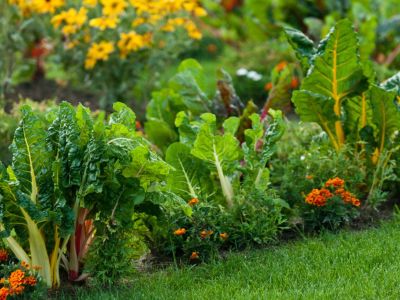Veggies, Herbs, and Flowers
The idea of mixing edible crops with ornamental plantings was once frowned upon. However, grouping veggies, herbs, and flowers together is a great way to add interesting textures and colors to the garden. Mixing vegetables and herbs with flowers creates year-round interest. Many gardeners also prefer to mix these plants to camouflage and repel pests.
Choosing Edible Landscape Plants
When adding edible landscape plants to flower gardens, consider the overall look of each plant and choose those that complement one another as well as those sharing the same growing requirements. For instance, some enjoy sun while others prefer shade. Some are tolerant of drought-like conditions while others require plenty of water. For best results, make sure when mixing vegetables and herbs with flowers, they are situated in the same beds as those sharing the same conditions. Mixing vegetables and herbs with flowers can increase garden yields and flower production. The flowers increase nectar production, attracting more beneficial insects that protect edible plants and pollinators that increase flower production. Companion planting also helps. For instance, certain vegetables, such as onions, can help deter aphid attacks on plants like roses. Marigolds have the same effect and work well with tomato plants, fending off snails. Another good example might include placing petunias with beans to repel bean beetles.
Landscaping with Vegetables
While there are a number of methods for landscaping with vegetables, here are a few suggestions to get you started:
Fill in empty areas of flower borders or beds with ornamental vegetables. Rhubarb has lovely cream-colored flower stalks that fit in nicely with flowering plants. Once asparagus crops have faded, their feathery foliage will add interest to the flower border. Put a little heat in the flower bed with peppers. Peppers come in a variety of colors and shapes, making them exceptional choices for flower borders and beds. Choose a variety that complements the surrounding flowers or foliage.
Landscaping with Herbs
Many edible herbs also work well mixed with flowers. Try some of the following ideas for landscaping with herbs:
Fill in empty spaces with parsley to add foliage interest. Basil is available in many varieties and this herb can be tucked into the garden as an accent nearly anywhere. Thyme, mint, and oregano can all be used as groundcovers in the flower garden. Many herbs have attractive flowers and fragrant foliage, which can be easily integrated into the garden such as pineapple sage, lavender, and bee balm.
Other Edible Landscaping Plants
Dwarf fruit trees and other edibles, such as berries and fruiting vines, look great when planted with flowers. Use dwarf fruit trees for accents or anchors to flower borders and island beds. Fruiting and flowering shrubs are also an asset of edible landscaping and good for adding structure. Edible plants, like strawberries, can also make delightful groundcovers in the flower garden. For even more beauty and extended blooms, mix some edible flowers in with your vegetables and herbs. It’s not only a great way to extend the look of the garden, but it will also increase your overall yields. After all, it’s an edible garden. Why not have the best of both.
